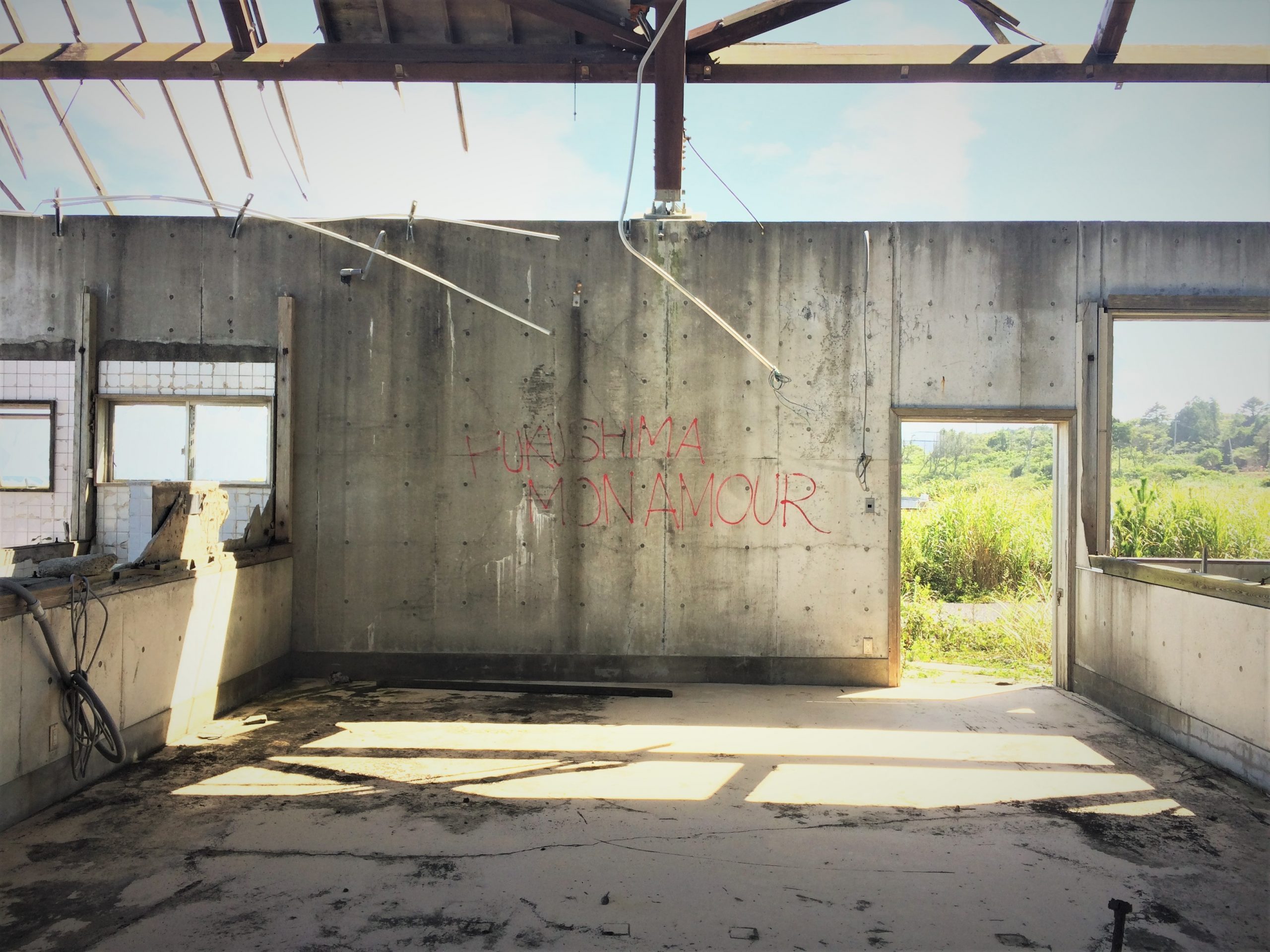This piece is the fourth part in the JAWS online series of Reflections from Tōhoku
“This is Namie. It’s now a ghost town”, said the tour guide as the bus stopped and we got off. An eerie silence filled the streets as we walked through Namie town, a town whose residents had had to evacuate in the wake of the Fukushima nuclear disaster in 2011. Although the houses looked intact, we knew that the place would remain empty and lonely for years to come. Cars were parked at the road, untouched and dusty. I peeked around a corner and found a flower growing from a crack in the street. When I kneeled down next to the various waste and broken road signs that lay on the ground to take a picture, I smiled sombrely in anticipation of Fukushima’s recovery process.
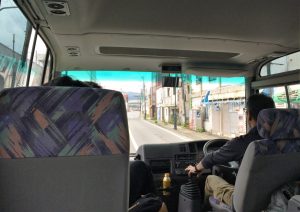
Arriving in Namie Town (Dunja Sharbat Dar)
Fukushima as a “non-place”
It was in 2014 when I decided to go to Fukushima University for an academic exchange. Only three years after the triple disaster 3.11, I knew my decision would anger, shock and disturb some people because the name Fukushima for many was associated with danger, thus becoming a “non-place” (see Arefi 1999 about non-places) in everyday conversations since 2011. You should not be voluntarily going there. I was confronted with my family and friends’ fear of nuclear disaster and contamination as well as the pressing question of whether or not the nuclear accident at Fukushima Daiichi would pose a health risk to anyone coming close to the coastal area.
Many of the people I spoke to about my plans believed Fukushima was empty, completely destroyed and fully contaminated – a conclusion that was driven by negative, biased and incomplete media coverage (see e.g., Friedman 2011). People told me I’d come back “radiating” and contagious, a stigma that residents of Fukushima were actively facing, and still face to this day (see Kwesell and Jung 2019). By 2014, academic literature and scientific work about the disaster had already been published, informing about the cause of the accidents, the risks of certain areas and the safe spaces in the prefecture. It showed that only a specific area was temporarily designated as the danger zone, while most of Fukushima and neighbouring prefectures were considered low risk areas (see e.g., Coulmas and Stalpers 2011; Kingston 2012). Yet, the fear remained, which was as much connected to negative media coverage and misinformation as it was linked to the Japanese government’s handling of the situation in the first few months after the catastrophe (see e.g., Friedmann 2011; Tkach-Kawasaki 2012; Slater 2012). Fukushima was socially constructed as a non-place by consumers of media from afar. People who have not yet gotten in touch with residents from Fukushima or have limited knowledge of the situation still often uphold this negative image, socially constructing a vacuum space and thereby overlooking the lived reality of Fukushima.
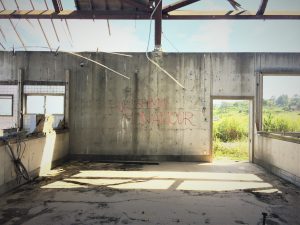
“Fukushima Mon Amour” graffiti on the walls of a destroyed factory in the exclusion zone (Dunja Sharbat Dar)
Recreating Fukushima as a “Place”
In spite of this criticism, I went to Fukushima in 2014. During my stay, I visited multiple towns, villages and cities in the prefecture. Often guided by locals, professors or friends, I was able to discover the manifold ways in which recovery had already taken place so early after 3.11. Life seemed back to normal in Fukushima City aside from decontamination work replacing contaminated soil throughout the whole prefecture, but it was a different story in Eastern Fukushima.
We visited temporary housing facilities with hundreds of especially older women and men who had to abandon their houses in the exclusion zone or lost everything as a result of the tsunami and earthquake. Their stories were painful to hear, particularly regarding their future: Would they ever be able to go back home? Many could not afford relocating and thus depended on the government’s support and financial help.
What would later develop into my research project, I was particularly interested in the response of the religious organisations to the disaster. Witnessing the loneliness of the evacuees, many religious and secular organisations had begun to arrange regular events and visits to these facilities, some of which I participated in. During these visits, recreating common traditions from the region (mostly food related, such as packing bento with regional products or drying kaki) was used as a means of establishing the feeling of continuity and belonging. The elderly people were able to share their knowledge and show their skills regardless of their situation, while us visitors brought the materials, and an open ear to listen to their experience.
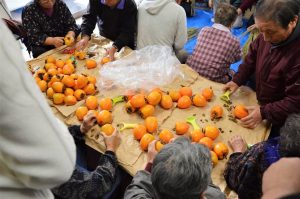
Kaki drying at temporary housing facilities (Dunja Sharbat Dar)
Many locals also struggled immensely to survive economically, specifically, the food industry. For a very long time, many avoided food from Fukushima and did not trust neither the governmental nor independent food testing services (see e.g., Reiher 2017). In Iitate, a group of women initiated the かーちゃんの力・プロジェクトふくしま (kaa-chan no chikara -project), preparing and packing fresh vegetables and food from Fukushima. These women were determined to change the misconception of Fukushima’s food and ingredients as inedible (see for more: Kiratto Fukushima 2016). Raising awareness about the situation in Fukushima to dispel fears stood at the heart of many such grassroots activities. A couple that used to farm mushrooms in the mountains of Fukushima prefecture and lost everything after 3.11 decided to tell their story with puppets: They handcrafted puppets and visited schools and events to raise awareness of how they try to cope with their situation. Having lost the means of income meant reconsidering how to sustain themselves. Their powerful message was critical and hopeful at the same time.
The few first years after 3.11 in Fukushima were difficult not only because of the devastation by the triple disaster, but also due to the lasting effects of contamination. The strong connections between the residents and the place made it possible for Fukushima to quickly adjust. But some things such as decontamination and the half-life period of the radioactive material was not something where the optics of the situation could simply be changed.
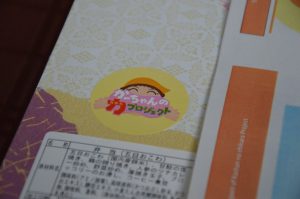
Kaa-chan no chikara-Project Logo (Dunja Sharbat Dar)
Shinto shrines in the exclusion zone
In 2018, I returned to Fukushima prefecture as a researcher of religion. At that time, some areas of the prefecture’s exclusion zone were reopened, while others remained closed. Although residents now had the chance to return to their homes, the long wait had made many already move afar. However, some, mainly older people, came back to places like Namie or Tomioka to start afresh. While many towns were now open for return, their character and social composition would look very different from the days before the disaster.
My research focused on such transformational processes, concentrating in particular on the changes in religious groups after the disaster. While I had previously visited shrines, churches and temples in Fukushima city that hardly experienced any changes, in my research I laid my focus on communities that had to relocate and rebuild their religious spaces elsewhere.
During my fieldwork, I learned from Shinto priests that 240 shrines were abandoned due to necessary evacuation and the ongoing risk of high radiation levels in the exclusion zone. Now, these shrines faced decay. I was told that in Shinto thought, shrines are very important for communal activity, encounter with the kami and religious rituals. Shrines do not only accommodate kami but also are important meeting places for the local community. As centres of Shinto festivals, shrines are regularly visited by people of different ages, jointly creating and celebrating on various occasions and making memories together. A shrine in the neighbourhood is more than just a religious building, it is their shrine and a place for their community (both living and passed away) to come together.
Likewise, shrines function as protectors of their surroundings and the places in which they stand. They hold guardianship over the nature and the lands, as well as the people who can ask for support when in need. So, shrines cannot simply be relocated, otherwise they would leave the place they are supposed to protect. They are not only religiously interesting, but function as essential manifestations of life and continuity in Fukushima as a space that continues to live on. After March 2011, majority of the people from East Fukushima had to be evacuated, and while some by now had received permission to move back, the former residents of the no-return areas cannot go back and might never be able to return. Nevertheless, the shrines in Futaba and Ōkuma Town for instance are still there. And they must stay there to further protect the area because in some decades maybe, if people will be allowed back, these shrines should be there to enable them to return to their communal and ritual life. As such, they remain homes to the former residents, metaphorically keeping the area alive, and through their maintenance recreate Fukushima’s exclusion zone, not as a ‘non-space’, but as a lived space.
Other shrines on the other hand have not needed to wait for the half-life of radiation to subside and have been rebuilt by the help of local, national and international volunteers. One example is the Yamada Shrine between Soma and Minami Soma. It is accessible and open to the public. The reconstruction was completed in 2016. Ever since then, Yamada Shrine is frequently visited by locals and former residents who pray for their future and remember their losses (see for more Sharbat Dar 2021).

The rebuilt Yamada Shrine complex. Between the building and the memorial stone excavators on an abandoned meadow visibly represent the ongoing transformation of Fukushima (Dunja Sharbat Dar)
Ongoing Challenges in Rural Fukushima
Officially, Namie is not a ghost town anymore, like it was when I first visited it in 2014. When visiting Namie and Tomioka later on, I learnt that the local government tried to initiate promotional events to motivate families and working individuals to relocate to Tomioka and start businesses. This is driven by their desire to revitalise Fukushima as an active, living space in opposition to being an abandoned area. The economic situation is still challenging for many of the smaller towns, since the number of returnees is small, which is also linked to the general problem of rural flight in Tohoku (see e.g., Thelen 2019). The local communities are trying to attract tourists and businesses, which is still difficult due to negative publicity and a lack of attractions. Aside from the aftermath of 3.11, the region doesn’t offer what younger people might be looking for. Reviving a local community is thus a challenge for the local government (the case of the town Minami Soma shows this, too. See Zhang et al. 2014). Nevertheless, emotionally, recreating the region’s communal activity and turning the ruins into homes is a necessary task for the government and communities.
My fieldwork in Fukushima over the years gave me an insight into the complexity of revitalisation, communal revival and regional recovery. I experienced the residents and volunteers as hopeful, future-oriented and determined to overcoming the struggles of the past step by step. Fukushima’s way to full recovery, also from being seen as a non-place, is still long, since trauma and only slowly decreasing radiation levels prolong the process of revitalisation. What was lost, may not come back. But Fukushima residents seem to be looking for a fresh start based on what they know, heading towards a wondrous future. Their goal is to revitalise Fukushima as a space full of activity and life.
Dunja Sharbat Dar is a PhD candidate at the Center for Religious Studies at Ruhr-University Bochum, Germany. She holds a B.A. in Japanese Studies and an M.A. in the Study of Religion. During her studies, she spent a year at Fukushima University, Japan, and returned there again in 2018 for research. Her main fields of interests are religion in Japan, popular culture and religious space.
References
Arefi, Mahyar: “Non‐place and placelessness as narratives of loss: Rethinking the notion of place”, Journal of Urban Design 4/2 (1999), pp. 179–93. doi: 10.1080/13574809908724445.
Coulmas, Florian and Judith Stalpers: Fukushima — Vom Erdbeben zur atomaren Katastrophe, München: C.H. Beck 2011.
FAP: “Fukushima Ambassadors Program”, http://english.adb.fukushima-u.ac.jp/program/ambassadors-program.html (last accessed: July 28, 2021).
Friedman, Sharon M.: “Three Mile Island, Chernobyl, and Fukushima: An Analysis of Traditional and New Media Coverage of Nuclear Accidents and Radiation”, Bulletin of the Atomic Scientists (2011), pp. 55–65.
Fukushima Prefectural Government: “Steps for Revitalisation in Fukushima”, March 27, 2019, 31; https://www.pref.fukushima.lg.jp/uploaded/attachment/337728.pdf (last access: August 20, 2019).
Kingston, Jeff (Ed.): Natural Disaster and Nuclear Crisis in Japan — Response and Recovery after Japan’s 3/11, London/New York: Routledge 2012.
Kiratto Fukushima: “キラっ人さん紹介: 渡邊 とみ子さん(かーちゃんの力・プロジェクト)”, https://www.kiratto-fukushima.jp/prelusion/prelusion.html?id=25 (last accessed: July 28. 2021).
Kwesell, Allison, and Joo-Young Jung: „A Multidimensional Analysis of Stigma: Findings from a Qualitative Study of Fukushima Residents Following Japan’s 2011 Nuclear Disaster“, Journal of International Crisis and Risk Communication Research 2/2 (2019), pp. 233–58. doi: 10.30658/jicrcr.2.2.4.
Reiher, Cornelia. „Food safety and consumer trust in post-Fukushima Japan“, Japan Forum 29/1 (2017), pp. 53–76. doi: 10.1080/09555803.2016.1227351.
Sharbat Dar, Dunja: „Surviving Disaster, Reviving Religion“. Zeitschrift für junge Religionswissenschaft 16 (2021), pp. 1–18. doi: 10.4000/zjr.1578.
Slater, David H.: “Social Media in Disaster Japan”, in: Jeff Kingston (Ed.): Natural Disaster and Nuclear Crisis in Japan — Response and Recovery after Japan’s 3/11, London/New York: Routledge 2012, pp. 94–108.
Thelen, Matthias: “Disaster and Salvation in the Japan- ese Periphery: ‘The Rural’ in Shinkai Makoto’s Kimi no na wa (Your Name)”, ffk Journal — Dokumentation des 31. Film- und Fernsehwissenschaftlichen Kolloquiums 4 (2019), pp. 215–230.
Tkach-Kawasaki, Leslie M.: “March 11, 2011 online — Comparing Japanese newspaper websites and International news websites”, in: Jeff Kingston (Ed.): Natural Disaster and Nuclear Crisis in Japan — Response and Recovery after Japan’s 3/11, London/New York: Rout- ledge 2012, pp. 109–123.
Zhang Hui et al.: “Radiation-Driven Migration: The Case of Minamisoma City, Fukushima, Japan, after the Fukushima Nuclear Accident”, International Journal of Environmental Research and Public Health 11 (2014), pp. 9286–9305.

